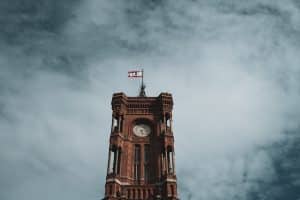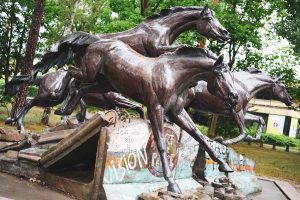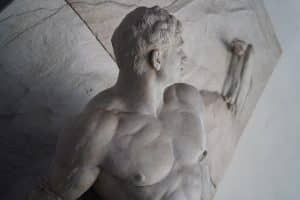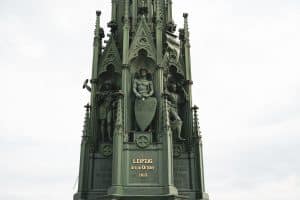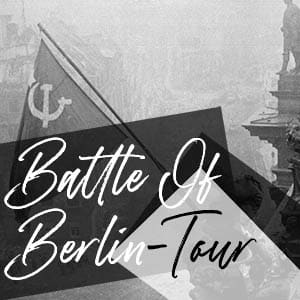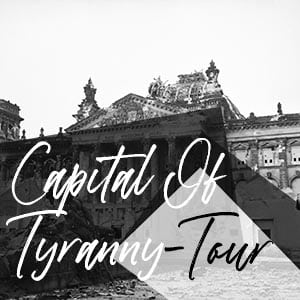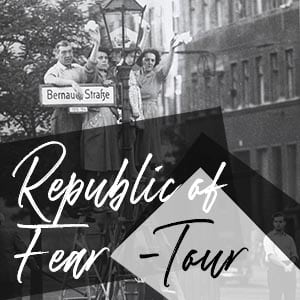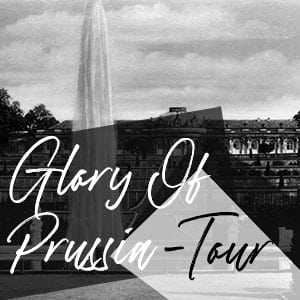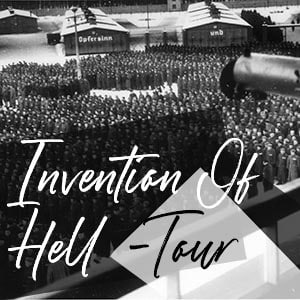Although often simplified such to the extent of competing compass-points – East and West – the Cold War era was infinitely more complex.
Defined in many ways as much by what it was as what is was not.
The division of Germany, and Berlin, 1945 into British, American, French, and Soviet zones of occupation brought with it – in time – a new form of conflict.
Allies in war found themselves uneasy bedfellows in peace and sought to usurp and undermine each other where possible in a new struggle for supremacy. The natural alliance between the capitalist countries of Great Britain, the United States, and France would be tested by the communist-socialist fervour of the Soviet Union and its satellite states.
But most importantly, this war would mainly burn ‘Cold’.
Unlike with the methods employed by the National Socialist movement in pursuit of its ideological goals, the Cold War, however, was not:
- A simple matter of battlefield attrition – where the last man standing gets to decide which monkey system wins.
- Racial superiority played almost no role in the Cold War conflict – unlike with the threat of Nazi Germany.
- And territorial expansion would have to be conducted in the shadow of potential nuclear annihilation.
Instead of large scale confrontation, proxy wars would be fought and insurrections sponsored; intervention by coup and spread of influence would be the flavour of the day.
All this would mean that the Cold War as it played out in Berlin was more a matter of intrigue, espionage, and a test of the true power of propaganda.
In essence, a story – or two competing stories – told by competing parties in pursuit of incompatible goals.
Berlin's Cold War Era Artefacts
As such, this period is perfect to explore by consulting the objects still scattered across the German capital.
Rich in symbolism and meaning, these artefacts reveal glimpses of those competing stories – they are jigsaw pieces in an immense puzzle.
- Token remnants of this not-so-distant past.
- Markers or memorials to glory and tragedy.
- And, more often than not, weapons harnessed by either side in a war of narrative.
A war where storytelling was paramount; where the side with the story that was most believable – or widely believed – stood a much greater chance of winning.
This collection of objects offers insight into the different aspects of that story.
An opportunity to gaze back towards the icy ideological tundra of the largest historical era of the 20th century – and inspect what is left spread across Berlin after the thaw.
Join us as we journey across the city on a Cold War quest; often funny, frequently absurd – always informative.
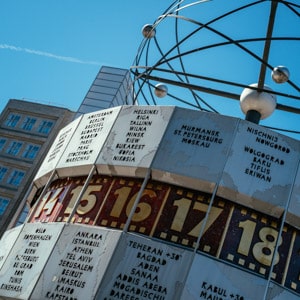
01 | The Weltzeituhr
The Weltzeituhr (World Clock) at Alexanderplatz has been a popular meeting spot since its installation in 1969, when this square was part of the capital of East Germany. As it rotates throughout the day, it is possible to make out the time in 148 major cities around the world – the clock is constantly in motion, although moving too slow to be noticed by the human eye.
Its unique design and history led to it being listed as a landmark of “historically outstanding importance” in 2015 – four years later the copyright was rescinded by the Berlin State, so now it is possible to buy souvenir versions of this technical marvel and meet elsewhere.
–
Address: Alexanderplatz 1, 10178 Berlin
Website: None
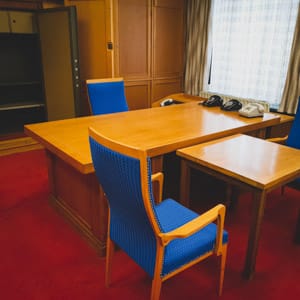
02 | Erich Mielke's Desk
Once the personal office of the East German ‘Master of Fear’ – Erich Mielke – head of the infamous STASI secret police, this preserved space is now part of the Berlin Stasi Museum in Lichtenberg. While considered secret for their activities, the existence of the East German state security service was in-fact well known to citizens and foreigners alike.
What lay beyond the public eye was the conspiratorial world behind the closed doors of the prisons and former administrative headquarters such as this site. Open to the public 7 days a week, the present day museum now allows an unrestricted view of the inner workings of one of history’s most secretive organisations.
–
Address: Normannenstraße 20, 10365 Berlin
Website: Stasi Museum
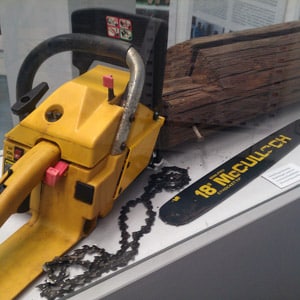
03 | Ronald Reagan's Chainsaw
While celebrated for calling on Soviet leader Mikhail Gorbachev to “tear down this Wall“, US President and Cold War warrior Ronald Reagan was himself no stranger to destruction of property. Reagan spent much of his presidency at home in his rural Rancho del Cielo – dubbed the Western White House – where the sound of his trusty chainsaw would echo through the valley, as the President took to chopping down trees for firewood and to build fencing – when not engaging in other manly pursuits.
The chainsaw is now one of the more unusual items to be found in the Checkpoint Charlie Museum – along with Gandhi’s sandals and Nikita Krushchev’s hat.
–
Address: Friedrichstraße 43-45, 10969 Berlin
Website: Museum Haus am Checkpoint Charlie
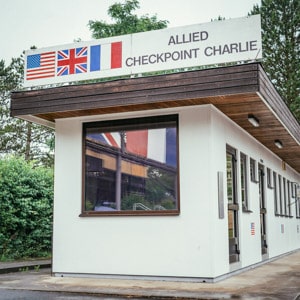
04 | Checkpoint Charlie
Beyond the Brandenburg Gate, no other object in Berlin better represents the Cold War division of the city – and antagonism between the competing Eastern and Western powers – than this Checkpoint Charlie border crossing box. Unlike the replica version that now stands in its place at the junction on Friedrichstrasse where the US military crossing once was – depicting the earlier wooden-hut form – this is the box that stood on the frontier when the Berlin Wall fell in 1989.
It is now on show outside the Allied Museum, near the US embassy, in the West Berlin district of Dahlem – although if you want to see the original wooden version, that is here too inside the museum!
–
Address: Clayallee 135, 14195 Berlin
Website: Allied Museum
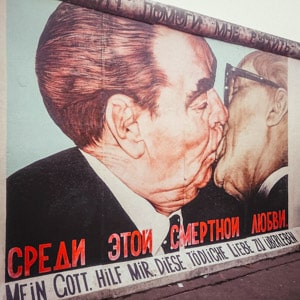
05 | The Berlin Wall Kiss
There is little of the Berlin Wall left visible in the city; of the around 160km that once stood – there is perhaps 15km remaining. The most famous section, known as the East Side Gallery, is now the largest and longest open air gallery in the world – covered in graffiti street art.
The most famous work, the Brezhnev-Hoenecker Kiss is based on a real event, captured as East German leader Hoenekcer and Soviet leader Brezhnev embraced back in 1979. A common fraternal pleasantry among leaders of Socialist states, the Brüderküss (Brotherly Kiss) was often considered a measure of the level of relations between the countries involved.
–
Address: Mühlenstraße 3-100, 10243 Berlin
Website: East Side Gallery

06 | The Cafe Moscow Sputnik
Once the pride of East Germany, the Karl-Marx-Allee boulevard stretches from Alexanderplatz east towards the city limits in the direction of the Socialist sister states. Previously there were restaurants named after the capital cities of those states along this grand avenue, where it was also possible to dine on the national cuisine.
Cafe Moscow is the only venue remaining, capped with this replica of the Soviet Sputnik – the first satellite launched into space back in 1957. With the launch of this small sacred object, the Soviet Union clearly demonstrated its position leading the Space Race at the time, 12 years before the United States put men on the moon.
–
Address: Karl-Marx-Allee 34, 10178 Berlin
Website: Cafe Moscow

07 | The Soviet Soldier
One of three major Soviet war memorials in Berlin, the Treptower Park memorial commerates 7,000 of the 80,000 soldiers who died in the Battle of Berlin in 1945. It features this 12-metre high statue of a Soviet soldier saving a child whilst triumphantly stood over a broken swastika, sword in hand.
This piece is, in-fact, part of a triptych stretching back to the Russian industrial city of Magnitogorsk – with a statue of symbolising the forging of the sword (the Rear Front Memorial) – to Volgograd and a female figure raising the sword (The Motherland Calls), leading finally to Berlin with the soldier can be seen finally driving the sword into the ground.
–
Address: Treptower Park, 12435 Berlin
Website: None
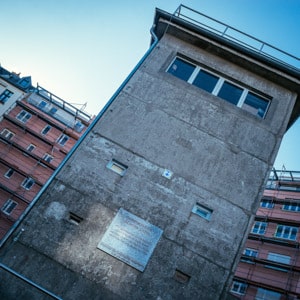
08 | The Guenter Litfin Tower
Günter Litfin’s death at the hands of East German transportation police while attempting to flee the country in 1961 set a dangerous new precedent. That the East German government would use deadly force to stop anyone from compromising the Berlin Wall. Litfin was shot and killed while attempting to swim across the Humboldt harbour to West Berlin on August 24th 1961 – he was a tailor by trade and had acquired a job in the British sector of the city.
This watchtower was taken over by Litfin’s surviving brother in 2003 and opened as a memorial – to the first person murdered due to the Berlin Wall. Sadly at least another 138 people would join this list until 1989.
–
Address: Kieler Strasse 2, 10115 Berlin
Website: Gedenkstätte Günter Litfin
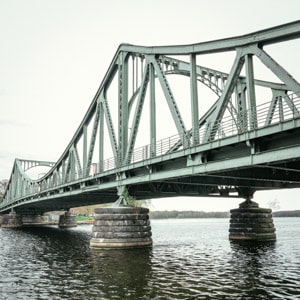
09 | The Bridge of Spies
A staple backdrop of any Berlin spy thriller, this iron bridge was constructed across the river Havel, served as a crossing point between the Soviet and US Cold War zones and would find fame due to a number of spy exchanges here – including that of U2 pilot Francis Gary Powers, for Soviet spy Rudolf Abel, back in 1962. Powers who had been shot down while on a top secret CIA espionage mission flying over the Soviet Union.
Despite its nickname – there were only three exchanges that took place here, in 1962, in 1985, and in 1986 – with the bridge chosen as it was the only crossing between the East and West that fell completely under Soviet, and not East German control.
–
Address: Königstraße, 14467 Berlin
Website: None
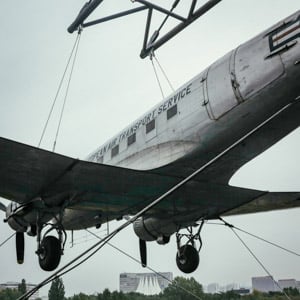
10 | The Candy Bomber
When Soviet leader, Joseph Stalin, attemped to starve West Berlin out of existence in 1948 – US, British, and French forces responded by undertaking the largest airlift ever carried out to import fuel, food, and supplies. The main workhorse of the US effort was the C47 Skytrain, nicknamed the ‘Candy Bomber’ due to the habit that some pilots had of tilting their wings on approach and dropping sweets to children gathered near the Tempelhof airport landing strip.
The airlift would continue for more than a year while the Western Allies gathered enough supplies in the city to better weather any future storm the Soviets might inflict.
–
Address: Trebbiner Strasse 9, 10963 Berlin
Website: Deutsches Technikmuseum
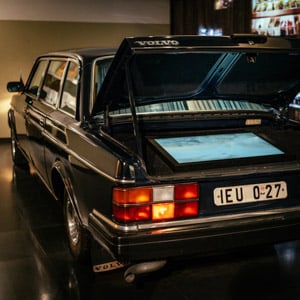
11 | The Bonzen-Volvo
While most East Germans able to procure a car had their choice limited to the rickety Trabant (the Trabi) or its larger and more powerful alternative – the Wartburg – important members of the ruling Politburo would be chauffeuered around in more luxurious Swedish Volvos. The decision was largely a matter of capital. When faced with importing Tatra limos from the Socialist brotherland of Czechoslovakia, the government opted for the quiter, more reliable – and cheaper – Volvo from neutral Sweden.
This 264TE limousine previously belonged to Party Secretary of the Economy, Günter Mittag, and is now on display at the DDR Museum.
–
Address: Karl-Liebknecht-Strasse 1, 10178 Berlin
Website: The DDR Museum
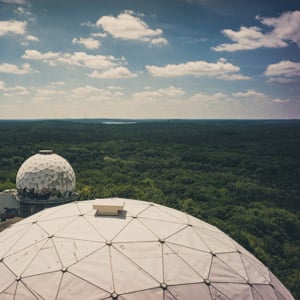
12 | The Teufelsberg Radomes
Often simply known as Teufelsberg (Devil’s Mountain) this now defunct facility was constructed as an NSA/CIA listening station during the Cold War period on top of a mountain of rubble scraped out of the city at the end of the Second World War.
Around 75 million m3 of debris between 1945 and 1965 was dumped here – on top of the remains of Albert Speer’s Military Technical College – producing the highest peak in Berlin (around 120m elevation). The former spy facility on top is now open to visitors as a museum and art space – with the radar domes sometimes use as exhibition spaces or for private dining.
–
Address: Teufelsberg, 14055 Berlin
Website: Teufelsberg Berlin
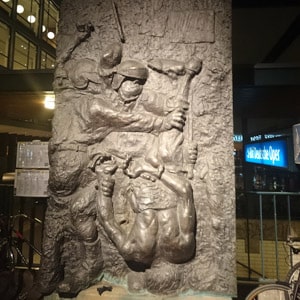
13 | Benno Ohnesorg Memorial
The murder of young protester, Benno Ohnesorg, in 1967, near the West Berlin opera house, would serve as an important turning point for post-war West German identity – as student groups rallied against what they saw as the internalised fascism of the state – particularly as Ohnesorg’s killer was a police officer.
While protesting against a visit from the Shah of Iran, Ohnesorg was shot by Karl-Heinz Kurras – who was later twice acquited of any wrongdoing. A result used as justification for the violence that militant groups, such as the Red Army Faction and the Movement 2nd June (named after the date Ohnesorg died), would unleash.
–
Address: Bismarckstraße 35, 10627 Berlin
Website: None
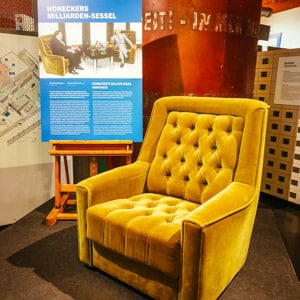
14 | Erich Hoenecker's Chair
The East German state struggled endlessly throughout its existence to balance its books – weighed down by its extensive spending on border controls, secret police, and subsidies – ever more so from the 1970s as ‘consumer socialism’ was introduced and the continuous trade deficit with the West threatened stability.
This olive green armchair was famously used by Erich Hoenecker in 1983 to receive Bavarian Prime Minister Franz Strauss and negotiate a one billion mark loan to help prop up the ailing state for another seven years – when the promised political concessions and economic reform finally arrived as a result of the ‘Fall of the Berlin Wall’.
–
Address: Karl-Liebknecht-Strasse 1, 10178 Berlin
Website: The DDR Museum
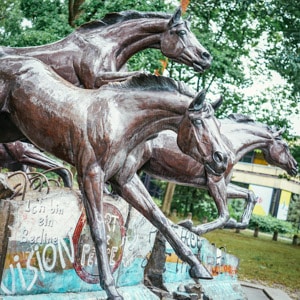
15 | The Fall Of The Wall Statue
One of two statues known as the Day The Wall Came Down created by US artist Veryl Goodnight reimagining the feverish excitement surrounding the end of the Berlin Wall – these five horses (one stallion and four mares) can be found galloping across damaged replica pieces of this infamous concrete barrier, near the US embassy on Clay Allee, in the west Berlin district of Dahlem. Described as a visualisation of the deep-seated humour desire from freedom, the statue was a gift from the United States government and was unveiled in 1998 by former US President George H.W. Bush.
The original version of this statue is now exhibited outside the George H. W. Bush Presidential Library in Texas.
–
Address: Clayallee, 14195 Berlin
Website: None
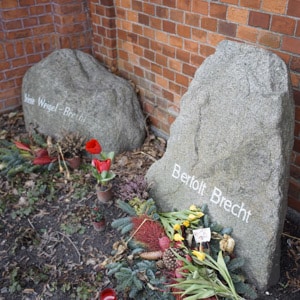
16 | Bertolt Brecht's Grave
One of the most well-known exile artists to return to Germany after the end of the Second World War, Bertolt Brecht followed his political convictions all the way back to East Berlin – where he had established his reputation as a writer during the Weimar-era and exponent of ‘dialectical theatre’. His work The Threepenny Opera – featuring the hit song Mack the Knife – was first performed at the Theatre am Schiffbauerdamm, transformed into the Berliner Ensemble by Brecht and his wife in 1949.
The celebrated playwright is buried in Berlin’s Dorotheenstädtischer cemetery alongside his wife and collaborator, actress Helene Weigel.
–
Address: Chausseestraße 126, 10115 Berlin
Website: Dorotheenstädtisch Friedhof

17 | The Red Suitcase
Holding the reins of power in a state such as Cold War East Germany could be a dangerous game, a country which despite its public image of Socialist camaraderie would expect its leaders to either ‘hang alone or hang together’ – for fear of factionalism (conspiring against the party and people). Politburo members often had as much to fear from each other as the Imperialist enemy.
A phenomenon embodied by this red suitcase, exhibited in the Stasi Museum, that belonged to secret police chief Erich Mielke – and contained documents implicating East German leader Erich Honecker in anti-Communist activites. Secrets kept to ensure his commitment to the cause.
–
Address: Normannenstraße 20, 10365 Berlin
Website: Stasi Museum
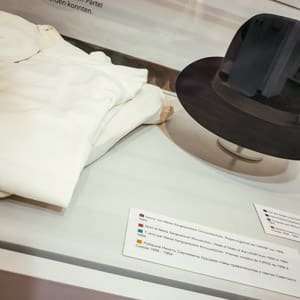
18 | Nikita Kruschev's Hat
At the height of the Cold War in the 1950s and 60s, the Soviet Union was ruled over by portly strongman Nikita Kruschev – who developed a penchant for banging his footwear on podiums mid-speech for added dramatic effect. After emerging victorious in the scramble to succeed Joseph Stalin in 1953, Kruschev would be left to wrestle with the recurring question of the status of divided Berlin and Germany – referring to West Berlin as a “malignant tumour”.
His hat and shirt, exhibited inside the Checkpoint Charlie museum, don’t have the star appeal of a Kruschev shoe – but prove that the man who once held the fate of the planet in his hands certainly wore big boy clothes.
–
Address: Friedrichstraße 43-45, 10969 Berlin
Website: Museum Haus am Checkpoint Charlie
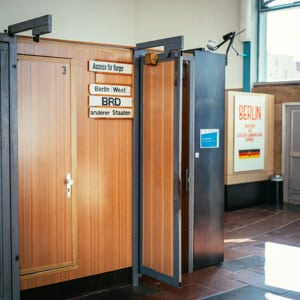
19 | The Passport Control Box
Following the construction of the Berlin Wall, in 1961, it would eventually be possible to cross from West Berlin into the East of the city as a tourist – although rarely the other way around. Visitors would commonly enter East Germany in a car or bus – although sometimes also by train. Friedrichstrasse station held the distinction of being the only crossing point that was actually inside East Berlin – where tourists disembark straight into the East rather than pass through a checkpoint on the border of East Berlin.
Returning home from here would involve passing through one of these threatening looking passport control cabins – still to be found in the former Friedrichstrasse station border control office.
–
Address: Reichstagufer 17, 10117 Berlin
Website: The Tränenpalast

20 | The Trabant
In East Germany, the Trabant (or Trabbi for short) would be touted as the car of the common man – or woman – even though each common person could expect to wait more than a decade, on average, to receive one – as car production was a low priority in comparison to western capitalist countries.
These sputtering fibreglass-shell junkers can still be seen cruising around the city – easily noticed due to their roaring engine sound and tell-tale smell. The butt of many a joke; the Trabant has stood the test of time and although hardly desirable now, their simple mechanics mean far more are still on the road that might be expected – as they are easy to repair.
–
Address: Zimmerstraße 100, 10117 Berlin
Website: The Trabi Safari Site
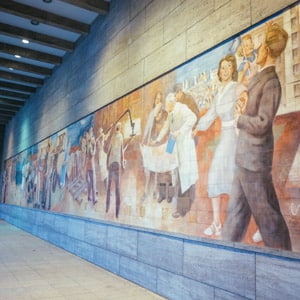
21 | The June 17th Mural
This mural was added to the exterior of the former Nazi Aviation Ministry in 1952 by artist Max Lingner at the request of the East German government – as by that time the building was being used as the House of Ministries for the German Democratic Republic. At 18 metres long, and painted on Meissen porcelain tile, this colourful panorama depicts the idealised Socialist utopia – complete with smiling teachers, workers, and politicians.
Tragically, it would serve as the backdrop to the uprising that would take convene on this square on June 17th 1953 – as East Germans called for democratic reforms and were instead met with Soviet tanks.
–
Address: Wilhelmstraße 97, 10117 Berlin
Website: The Federal Finance Ministry

22 | The Doner Kebab
Whether it was truly invented in Berlin is still debated to this day, also certainly it is hard to deny that the Döner Kebab is an essential part of the city’s foodscape. This mixture of shaved meat, vegetables, and sauce, usually served wrapped in a triangle-shaped pita bread is a staple snack – widely available across the city and consumed with or without alcohol.
The first Döner Kebab in Berlin is said to have been served at the Zoologischer Garten train station by Turkish-German immigrant Kadir Nurman – although if you’re looking for an authentic Berlin Döner now, you would be best venturing into the neighbourhoods of Kreuzberg and Neukölln.
–
Address: Various Locations
Website: None
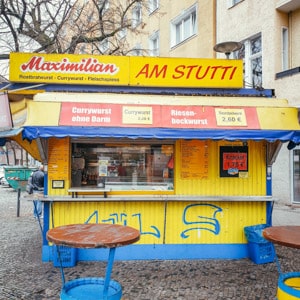
23 | The Currywurst
Back during Berlin’s heady Cold War days, the hot Currywurst became an icon of ingenuity in the face of shortages – as a resourceful sausage seller named Hertha Heuewer combined chopped sausage with an improvised tomato ketchup sauce to make this tasty snack.
While Heuwer’s Imbiss (snack stop) is long gone – the company that supplied her sausages and helped design her trademark sauce still exists and serves up this Berlin staple near Charlottenburg S-bahn station – look out for the little yellow hut and you’ll find Maximilian. Over the road, there is still a sign to indicate where Hertha Heuwer’s Currywurst shop used to be (now an Asian supermarket).
–
Address: Kaiser-Friedrich-Straße 52, 10627 Berlin
Website: None

24 | The Ketwurst
While the Currywurst rose in popularity in the West of Berlin during the Cold War period, the East German authories on the other side of the Berlin Wall responded by introducing their own equivalent (almost) – the Ketwurst. Inspired by the Currywurst, this German sausage is presented inside a carved out bread, stuffed with sausage and tomato sauce – that is then smeared on top to complete the look – although lacking in the spice of its Western sister snack.
A rarity still to be found if you know where to look. One of the city’s original Ketwurst stands still exists next to the Schönhauser Allee train station in the district of Prenzlauer Berg – the Alain Snack stop.
–
Address: Schönhauser Allee 116a, 10437 Berlin
Website: None

25 | Wolf Biermann's Mic
One of the most controversial voices to come out of East Germany – singer and songwriter Wolf Biermann recorded an entire album in 1968 using this Sennheiser microphone, which needed to be smuggled into East Berlin after Biermann had been placed on a government blacklist as a ‘Class Traitor’.
The subsequent release would solidify his stance as a critic of the East German state’s Stalinist policies and lead to him being kicked out of the country in 1977. The microphone is now on display at the Tränenpalast museum, a short distance from Biermann’s old Chausseestrasse 131 apartment where the album (also called Chausseestrasse 131) was recorded.
–
Address: Reichstagufer 17, 10117 Berlin
Website: The Tränenpalast

26 | The White Crosses
This memorial for some of the known victims of the Berlin Wall, is one of two in this area and can be found a short walk from the German parliament and the Brandenburg Gate – close to the line where the Wall once ran through the city. The other is on the bank of the river Spree.
Although it does not document the names of all of the 140 people who fell victim to the East German government policy of securing its border with concrete and bullets – some of the more well-known victims, such as Chris Gueffroy, Ida Siekmann, and Günter Litfin feature. There is also a cross dedicated to the victims of the 1953 Uprising and the violent response from the Soviet and East German authorities.
–
Address: Ebertstrasse, 10117 Berlin
Website: None

27 | The Panzerdenkmal
Driving into what was West Berlin from former East Germany, through the old Checkpoint Bravo border crossing, you will now encounter this strange art installation featuring a pale pink snow loader pointing into the sky, high on top of a pedestal.
For much of the Cold War period there was a Soviet T-34 tank mounted on this concrete spike, facing into the US sector of Berlin, and said to serve as a war memorial for the Soviet soldiers who had fallen in the Battle of Berlin. This was replaced in 1992 by the pink snow loader – perhaps as a comical reference to the recently ended Cold War – and that it was finally time to shovel away the chilly antagonism?
–
Address: Neubauernsiedlung 5, 14532 Kleinmachnow
Website: Checkpoint Bravo
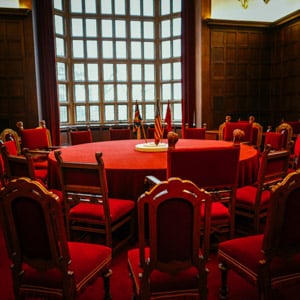
28 | Potsdam Conference Table
When Harry S. Truman, Joseph Stalin, and Winston Churchill, the leaders of the Big Three nations to have collectively defeated Nazi Germany, met for the final time in 1945 – the Cecilienhof Palace in Potsdam would serve as the venue for their first, and last, post-war plenary sessions. Completed in 1917, it was the last of the palaces built for the German royal family, in a distinctive Tudor style.
It was chosen for the Potsdam Conference not only for the security it offered, surrounded as it is by plenty of open land, but also the configuration of the interior – with its main meeting room with three entrances for the Big Three leaders – to sit around a purpose-built round table as equals.
–
Address: Im Neuen Garten, 14469 Potsdam
Website: Schloss Cecilienhof

29 | The Ampelmann
In the feverish days of the early 1990s many remnants of the East German era were erased, demolished, or intentionally neglected. The Ampelmann is a rare survival story. East Germany’s unique traffic light man – who remains a popular and celebrated object in the Berlin cityscape.
This cult icon is still a relatively good indicator of which side of divided Cold War Berlin you would have once found yourself – as the Western part of the city had the more generic figures that largely still grace that side today. Copyrighted and trademark in the 90s, the Ampelmann is now available in souvenir shops – on coffee mugs, t-shirts, and in gummi bear form.
–
Address: Various Locations
Website: The Ampelmann Store
Explore these sites and more with a private guide in Berlin via Berlin Experiences.
Our Related Private Tours
Learn more about the Battle of Berlin and explore this urban battlefield with our Battle of Berlin tours.
Learn more about the history of Nazi Germany and life in Hitler’s Third Reich with our Capital Of Tyranny tours.
Learn more about the history of East German and life behind the Iron Curtain with our Republic Of Fear tours.
Learn more about the history of Prussia and the life of Frederick the Great with our Glory Of Prussia tours.
Learn more about SS ‘Protective Custoday’ on our Sachsenhausen Concentration Camp Memorial tours.


